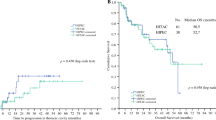Abstract
Purpose
The purpose of this study was to review the results of a single-center experience in the management of “closed abdomen” hyperthermic intraperitoneal chemotherapy (HIPEC) using a sophisticated technical device (EXIPER®) in the palliative setting of neoplastic ascites from peritoneal carcinomatosis in patients with advanced cancer of different primary sites.
Patients and methods
The study was an open, prospective, single-center, non-randomized study conducted at the Department of Medical Oncology 1, University of Cagliari, Italy, from May 2006 to October 2012. Fifteen patients with peritoneal carcinomatosis were treated with HIPEC: 5 males and 10 females (age range 51–82, median 62 years), for a total of 30 procedures (5 patients were treated more than once). Malignant ascites were from ovarian, uterine cervical, colorectal, gastric, malignant pleural mesothelioma, and unknown primary cancer. Main endpoints were increase of free interval between two consecutive procedures, progressive reduction of ascites volumes and improvement of quality of life assessed with ECOG performance status and EORTC QLQ-C30 questionnaire, and improvement of immunologic function.
Results
Twelve patients were completely evaluable while three patients were “lost” to follow-up. The treatment was well tolerated. The mean free interval between two consecutive drainages increased from 11.2 to 39.5 days. The mean ascites volume drained decreased from 7.8 to 1.8 l. ECOG PS improved in the majority of patients and EORTC QLQ-C30 scores in all patients as well as immunologic function. In September 2015, only one patient was still alive.
Conclusions
Our study shows that good results may be achieved in terms of symptom palliation and improvement of quality of life in very advanced cancer patients with MA from PC. The treatment was generally well tolerated considering the limited treatment options available for these patients.



Similar content being viewed by others
Abbreviations
- CS:
-
Cytoreductive surgery
- HIPEC:
-
Hyperthermic intraperitoneal chemotherapy
- IP:
-
Intraperitoneal
- MA:
-
Malignant ascites
- PC:
-
Peritoneal carcinomatosis
References
Cavazzoni E, Bugiantella W, Graziosi L, Franceschini MS, Donini A (2013) Malignant ascites: pathophysiology and treatment. Int J Clin Oncol 18:1–9
Sangisetty SL, Miner TJ (2012) Malignant ascites: a review of prognostic factors, pathophysiology and therapeutic measures. World J Gastrointest Surg 4:87–95
Sommariva A, Zagonel V, Rossi CR (2012) The role of laparoscopy in peritoneal surface malignancies selected for hyperthermic intraperitoneal chemotherapy (HIPEC). Ann Surg Oncol 19:3737–3744
Facchiano E, Risio D, Kianmanesh R, Msika S (2012) Laparoscopic hyperthermic intraperitoneal chemotherapy: indications, aims, and results: a systematic review of the literature. Ann Surg Oncol 19:2946–2950
Sugarbaker PH (2012) Cytoreductive surgery plus hyperthermic perioperative chemotherapy for selected patients with peritoneal metastases from colorectal cancer: a new standard of care or an experimental approach? Gastroenterol Res Pract 2012:309417
Sugarbaker PH, Ryan DP (2012) Cytoreductive surgery plus hyperthermic perioperative chemotherapy to treat peritoneal metastases from colorectal cancer: standard of care or an experimental approach? Lancet Oncol 13:e362–e369
Sugarbaker PH (ed) (2012) Cytoreductive surgery and perioperative chemotherapy for peritoneal surface malignancy. Texbook and Video Atlas. Cine-Med publishing, Woodbury
Glehen, Kwiatkowski M, Sugarbaker PH, et al. (2004) Cytoreductive surgery combined with perioperative intraperitoneal chemotherapy for the management of peritoneal carcinomatosis from colorectal cancer: a multi-institutional study of 506 patients. J Clin Oncol 22:3284–3292
Huang CQ, Yang XJ, Yu Y, Wu HT, Liu Y, Yonemura Y, Li Y (2014) Cytoreductive surgery plus hyperthermic intraperitoneal chemotherapy improves survival for patients with peritoneal carcinomatosis from colorectal cancer: a phase II study from a Chinese center. PLoS ONE 9:e108509
Yonemura Y, Fujimura T, Nishimura G (1996) Effects of intraoperative chemohyperthermia in patients with gastric cancer with peritoneal dissemination. Surgery 119:437–444
Rossi CR, Pilati P, Mocellin S, et al. (2003) Hyperthermic intraperitoneal intraoperative chemotherapy for peritoneal carcinomatosis arising from gastric adenocarcinoma. Tumori 2:54–57
Bijelic L, Sugarbaker PH (2012) The role of intraperitoneal chemotherapy in the treatment of patients with advanced gastric cancer. Ann Ital Chir 83:224–231
Piso P, Dahlke MH, Loss M, Schlitt HJ (2004) Cytoreductive surgery and hyperthermic intraperitoneal chemotherapy in peritoneal carcinomatosis from ovarian cancer. World J Surg Oncol 2:21
Verwaal VJ, van Ruth S, de Bree E, van Slooten GW, van Tinteren H, Boot H, Zoetmulder FAN (2003) Randomized trial of cytoreduction and hyperthermic intraperitoneal chemotherapy versus systemic chemotherapy and palliative surgery in patients with peritoneal carcinomatosis of colorectal cancer. J Clin Oncol 21:3737–3743
Gesson-Paute A, Ferron G, Thomas F, de Lara EC, Chatelut E, Querleu D (2008) Pharmacokinetics of oxaliplatin during open versus laparoscopically assisted heated intraoperative intraperitoneal chemotherapy (HIPEC): an experimental study. Ann Surg Oncol 15:339–344
Oken M, Creech R, Tormey D, et al. (1982) Toxicity and response criteria of the Eastern Cooperative Oncology Group. Am J Clin Oncol 5:649–655
Aaronson NK, Ahmedzai S, Bergman B, et al. (1993) For the European Organization for Research and Treatment of Cancer QLQ-C30: a quality-of-life instrument for use in international clinical trials in oncology. JNCI 85:365–376
Cancer Therapy Evaluation Program, Common terminology criteria for adverse events, Version 3.0, DCTD, NCI, NIH, DHHS March 31, 2003 (http://ctep.cancer.gov), Publish Date: August 9, 2006
Liu L, Zhang N, Min J, Su H, Wang H, Chen D, Sun L, Zhang H, Li W, Zhang H (2016) Retrospective analysis on the safety of 5,759 times of bedside hyperthermic intra-peritoneal or intra-pleural chemotherapy (HIPEC). Oncotarget. doi:10.18632/oncotarget.7622
Author information
Authors and Affiliations
Corresponding author
Ethics declarations
Conflict of interest
The authors declare that they have no conflict of interest. We confirm that we have full control of all primary data and we agree to allow the Journal of Supportive Care in Cancer to review our data if requested.
Additional information
Giovanni Mantovani is a Former Full Professor of Medical Oncology, University of Cagliari.
Rights and permissions
About this article
Cite this article
Orgiano, L., Pani, F., Astara, G. et al. The role of “closed abdomen” hyperthermic intraperitoneal chemotherapy (HIPEC) in the palliative treatment of neoplastic ascites from peritoneal carcinomatosis: report of a single-center experience. Support Care Cancer 24, 4293–4299 (2016). https://doi.org/10.1007/s00520-016-3262-7
Received:
Accepted:
Published:
Issue Date:
DOI: https://doi.org/10.1007/s00520-016-3262-7




